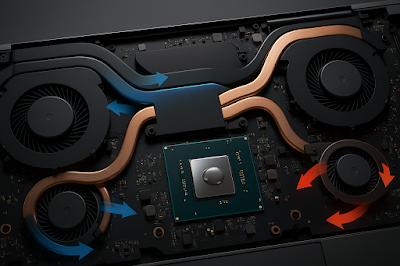In this deep dive, we examine how today’s desktop and laptop silicon balances blistering performance with tight power and thermal constraints. We start by unpacking Intel’s Arrow Lake Core Ultra 200HX series—up to 24 cores with 5.5 GHz boosts in a 28–45 W envelope and the disaggregated Meteor Lake design that separates CPU, GPU, SoC, and I/O tiles for efficiency. On the AMD side, we compare Zen 4 desktop chips (e.g., Ryzen 9 7950X peaking at 95 °C TJMax) with upcoming Zen 5 CCDs packing 8.315 billion transistors—a 28 percent density gain on TSMC N4P. We then explore NVIDIA’s Ada Lovelace GPUs delivering up to 4× generational gains via DLSS 3 and redesigned SMs. Next, we dissect real‑time control mechanisms—Intel Speed Shift (sub‑millisecond bin shifts) and AMD Precision Boost Overdrive (extended power ceilings) before surveying advanced cooling: dual‑fan vapor chambers in MSI’s Titan 18HX and Lenovo Legion Pro 7 Coldfront 5.0, plus liquid‑metal TIMs in ASUS ROG (≈10 °C drop) and longevity caveats on Framework’s Laptop 16. Finally, we quantify sustained performance: gaming notebooks rocking Core Ultra 9 285HX + RTX 50‑series, Ryzen 9 7950X in 65 W Eco mode beating Intel’s 12900K by 160 W, and workstation GPUs like the RTX 6000 Ada doubling perf‑per‑watt over Ampere.
Advanced Fabrication Processes: Intel and AMD Node Shrinks
Intel Arrow Lake: Core Ultra 200HX Series
Intel’s Core Ultra 9 285HX leads the Arrow Lake mobile family with 24 total cores (8 P‑cores + 16 E‑cores), reaching 5.5 GHz boost clocks within a 28–45 W power envelope—ideal for thin gaming laptops that need desktop‑class punch.
Intel Meteor Lake: Disaggregated Tiles
Meteor Lake marks Intel’s shift to chiplet‑style packaging: four active tiles (CPU, GPU, SoC, I/O) on a passive interposer. This disaggregation improves yields and power efficiency by fabricating each tile on an optimal process node.
AMD Zen 4 vs. Zen 5: Density and Efficiency
AMD’s Ryzen 9 7950X (Zen 4, TSMC N5) sustains up to 95 °C junction temperatures before throttling, with conservative boost curves to protect longevity. The forthcoming Zen 5 CCDs on TSMC N4P pack 8.315 billion transistors per die—a 28 percent density jump over Zen 4—promising significant perf-per‑watt gains in both gaming and professional workloads.
Real‑Time Voltage/Frequency Control
Intel Speed Shift
Intel Speed Shift hands voltage/frequency adjustments to on‑die hardware, cutting transition latency from ~1 ms (SpeedStep) to 0.1 ms, thus smoothing performance under bursty loads.
AMD Precision Boost Overdrive (PBO)
AMD’s PBO raises the default power limits automatically when motherboard VRMs can handle extra current, extending high‑frequency windows without manual overclocking—often resulting in lower sustained temperatures thanks to fewer voltage spikes.
Cutting‑Edge Cooling Solutions
Vapor Chamber Designs in Laptops
- MSI Titan 18HX employs a large vapor chamber with two 70 mm fans and four exhaust vents to dissipate up to 330 W of combined CPU+GPU heat.
- Lenovo Legion Pro 7 Coldfront 5.0 pairs boosted air intakes with ultra‑thin heat pipes and dual liquid metal blocks to keep high‑TDP Ryzen 9 and RTX 40‑series GPUs in check.
Liquid‑Metal Thermal Interfaces
- ASUS ROG gaming laptops use liquid‑metal TIM on CPU lids, shaving up to 10 °C off peak temperatures compared to standard paste.
- Framework Laptop 16 users report that while liquid metal offers superb conductivity (≈72 W/m·K), it suffers “pump‑out” over years, requiring reapplication.
Desktop GPU Cooling & Efficiency
NVIDIA’s Ada Lovelace architecture (e.g., RTX 4090, RTX 6000 Ada) achieves 2–4× ray‑trace performance over Ampere and delivers doubling of perf-per-watt at a 300 W TGP, thanks to revamped SMs and enhanced memory subsystems.
Sustained Performance and Power Modes
Gaming Notebooks: Core Ultra 9 285HX + RTX 50‑Series
MSI’s RTX 50‑series laptops, powered by Core Ultra 9 285HX, sustain 5.5 GHz CPU boosts and 2.4 GHz GPU clocks in Ultra modes, delivering desktop‑level framerates in a 28–45 W package.
Desktop Eco Modes: Ryzen 9 7950X at 65 W
Setting a Ryzen 9 7950X to 65 W Eco mode in Cinebench R23 yields nearly identical single‑thread scores and beats Intel’s Core i9‑12900K multi-thread by drawing 160 W less overall.
Workstation GPUs: Ada Lovelace in RTX 6000 Series
The RTX 6000 Ada professional card holds the same 300 W TDP as its Ampere predecessor yet doubles throughput in ray tracing and AI compute, slashing render times and power bills for studios.
Build Considerations
Modern PC silicon isn’t just about peak clocks; it’s about sustaining those clocks efficiently. By leveraging advanced process nodes (3 nm & 4 nm), on‑chip DVFS (Speed Shift, PBO), and next‑gen cooling (vapor chambers, liquid metal), manufacturers deliver laptops and desktops that sprint without burning out—so whether you’re gaming at 4 K, rendering multi-hour videos, or crunching AI models, you’ll get the power you pay for, when you pay for it, and only what you need.






👉 Check out the full EC course series here: https://innovatxblog.blogspot.com/2025/04/modern-electronics-communication-ec.html
ReplyDelete